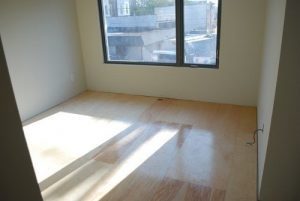Often used to install sub flooring over framing joists, tongue, and groove plywood creates a stable base and is surprisingly easy to install. Many tongue and groove plywood types are available, including those manufactured specifically for decking, sub floor, and siding projects.
Types of Tongue and Groove Plywood
First conceived in the 17th century, tongue and groove is a format that allows pieces of construction material to be joined without fasteners. It was first used in creating flooring and is now available in various formats, including all sorts of plywood designed for making various building projects more attractive and better functioning.

Depending on the supplier, you’re likely to be able to find just about any plywood milled with tongue and groove. Pressure-treated and non-pressure-treated options are available, as are various veneer faces, sizes, and thicknesses. If you like the idea of using a certain type of plywood but can’t find it milled with tongue and groove, check to see whether a local mill can handle the task of cutting tongue and groove in plywood you have purchased somewhere else.
Benefits
Plywood milled to create tongue and groove edges costs a little more than standard plywood panels, but some great benefits come with spending just a bit more upfront. First, you will likely save much time as aligning your panels will be simple. Second, and more importantly, you’ll get nice, tight seams that create a superior finished project that stands up to wear and tear. Floors built with tongue and groove plywood are less likely to squeak, even recommended by U.S. Department of Housing and Urban Development sound transmission class guidance. When properly constructed, they are perfectly level.
Using tongue and groove plywood for marine and exterior applications such as siding helps to keep moisture out, particularly when you use the right finish and pay extra attention to the edges. Pressure-treated tongue and groove plywood offer even more protection. Products formulated with waterproof glue are also highly desirable for use in projects exposed to the elements or subject to moisture exposure, such as that common in high-humidity areas.
Professional Recommendations for Installing
Tongue and groove plywood comes in a variety of grades and thicknesses as well as at different price points, and it’s available at most venues specializing in building supplies. Ensure you purchase plywood thick enough to meet the demands, and always install your plywood good side up. Check whether the glue is recommended, and always follow the manufacturer’s instructions when using glue to create tighter bonds.
Although tongue and groove plywood installation is a foolproof process that even someone fairly new to the DIY world can do, be sure you have a complete plan before beginning your project. You’ll need a few special tools to install this plywood for flooring, including a stout rubber mallet for tapping the panels together to ensure they are completely joined. Finally, if your budget allows, spend more on the high-quality tongue and groove plywood for easier installation and long-lasting results.




